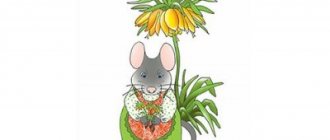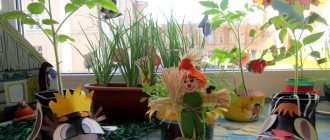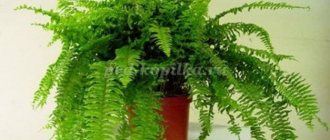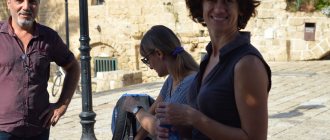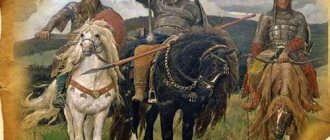Ant "professions"
There are many of them. Among them:
- Invading warriors. Their main task is to seize new territories and attack neighboring anthills to steal cocoons and larvae, which later become slaves working for the prosperity of someone else's anthill.
- Builders. They maintain the condition and structure of the anthill, build new communications and tunnels. As the size of the colony increases, every day hundreds of builder ants carry twigs and needles from above to the deeper layers of their home, and lift them up from the lower floors. This maintains stable humidity. Thanks to this, the dome of the anthill does not mold or rot.
- Orderlies. Sick ants are isolated from society; if a patient's leg is damaged, the orderlies amputate it - they simply chew it off.
- Getters. Their main task is to find and then carefully store food.
- Security guards. These individuals reliably protect the entrances to the anthill from strangers and ensure the safety of the larvae and the queen.
- Shepherds (milkers). Ants have "pets". Aphids feed on vegetation and secrete a sweet liquid called honeydew. Ants tickle aphids and collect sweet nectar, which is a nutritious and tasty food and source of carbohydrates for them.
- Transporters - carry honeydew into the anthill.
- Maternity hospital workers. The eggs are transferred to special compartments and are responsible for maintaining the desired temperature.
- Guardians of nectar. These workers are necessary in case of famine in the anthill, when the foraging ants will not be able to bring food. In this case, products are used that are always stored in abundance by thrifty keepers.
Depending on the number of insects living in the anthill, a division of labor occurs. In a small family, the principle of interchangeability is practiced. In a large colony, specializations emerge and the ants are assigned certain responsibilities.
Internal organization
From the inside, the anthill amazes with the thoughtfulness and well-functioning work of the builders. Inside, this structure is a collection of passages - an anthill, with many exits and various chambers. The structure goes deep underground, is divided into two parts and houses a whole colony of hardworking inhabitants.
Insects spend most of their time in the upper tier and live here during the warm season. The chambers are well heated, and all conditions for raising offspring are created here. The lower part, which goes one and a half to two meters underground, has similar structures. It is designed for wintering insects that wait out cold weather underground and store food reserves.
Each part is divided into chambers that perform specific functions:
- Queen's room. The queen lives in it and lays eggs there. It is looked after by worker ants who lay eggs.
- Egg storage. The ants bring eggs here and ensure that conditions are provided for their development.
- Chamber for larvae. The hatched ants are shaped like worms and are characterized by their insatiable gluttony. They are placed several in one chamber and provided with food.
- The anthill structure also includes a food storage room. Moreover, there are separate rooms for grains, seeds, insect parts, and aphids.
- Garbage storage warehouse.
- Wintering room.
The chambers are connected by numerous passages, which are carefully guarded by soldier ants. With the onset of cold weather or the approach of danger, the openings of the ant house close.
Do ants have enemies and who destroys anthills in the forest? These insects have plenty of enemies. If in the city even pets - dogs or cats - can cause damage to an anthill, then in the forest bears pose a great danger to them. The clubfooted owner of the taiga uses his clawed paw to rake anthills to feast on larvae and ants. Hedgehogs, like mice, will not refuse a light snack if they encounter an anthill on their way.
Many of us have known about the structure of ant homes since school, and most know that they cannot be destroyed. Unfortunately, the reality is different.
Myrmecologists are engaged in serious research into the life of these hardworking insects.
Calculations
Million-dollar niche, weak competitors, experience in the agricultural niche, special equipment (in fact, a product), developing ratings. We work within the framework of these competencies.
- For 1000 rubles a day you need 20,000 traffic (we don’t count affiliate programs, but everything according to the old scheme and very pessimistic, 50 rubles per 1000 on direct)
- The KPI of articles is 400 in the first year, so you need to write out (again according to the old scheme, even though we are now making small cards) - 1,500 articles
- One article = 500 rubles turnkey (already with placement), total investment 750,000 rubles
- Payback after reaching the planned income: 25 months
This is really fucked up, guys... Everyone around me thinks so, but I’m categorically not happy with it. Therefore, lower is more optimistic.
- 1000 rubles per day is a maximum of 10,000 traffic (yes, because we don’t have projects that bring in less than 100 rubles from 1000 in direct, and this also does not take into account affiliate programs, because everything is done with an emphasis on the product, and there are already 200 /1000 minimum)
- KPI is still 400, well, simply because this is the first year. And in the second one you can easily qualify for 800. But you already need about 750 articles.
- One article is 500 rubles. And the investments are already 375,000 (well, maybe 400).
- And the payback as a result is about 12 months.
Where did you miscalculate? What did you not take into account?
Taking into account the deadline, investments per month amount to about 47,000 rubles. Therefore, we stop eating khinkali, buying vacuum cleaners for 60k, drinking whiskey for 10k per bottle and behaving more modestly. At the same time, we transfer almost all the income from the sites to reinvestment (old projects are also being developed, but the focus is on the new one) for 200 days.
Development requires about 30k rubles. Only 120 were planted in boletus. But this is what it was made for, so that we could have solutions that would then allow us to save a lot on development and launch.
Progress of the game: One driver is an elephant, the rest are ants.
Elephant: “Let the ants walk and dance from the heart .”
Children dance as they please.
Elephant: " The ants ,
I'm tired of them.
The elephant went for a walk
Trample ants!»
The ants scatter , the elephant tries to catch them - to touch the ant . From those who were not caught, a leading elephant is chosen using a counting rhyme.
Target walk " Ants "
Goal: expand children's understanding of ants - workers ; expand your vocabulary; cultivate a caring attitude towards insects;
Ant farm (formicarium) Ready business project. Part 1
I didn’t think that ants would become so popular, keep a ready-made business project. Print farms, catch ants. It all started with the desire to have a pet. Having suffered with fish and birds and all sorts of smelly rodents, I decided to get ants because... I wanted as little care as possible and a minimum of responsibility. They are a completely independent organization, they don’t care about the owner, they cook their own food, take out the trash themselves, don’t yell, don’t smell. Throw in some food, fill up with water and you don’t have to worry about them (Reaper ants), you can even leave for a long time without fear of dying from hunger or destroying your apartment, as was the case with my cat :)
Looking at an anthill is always interesting, you take your mind off everyday worries, think about the eternal... You observe your own microcosm, imagining that you are God for them:)
But experiments on them are a completely separate topic.
I designed the formicarium according to criteria from personal experience:
- The anthill must be vertical (to allow observation from different sides)
- Not large in size so that it does not take up much space on the desk (120x120x120mm)
- Built-in light (plays a very important role for putting children to sleep as a night light)
- Presentable appearance (well, I don’t like the plexiglass molds with bolts, somehow it’s not right IMHO)
- Can be assembled and disassembled without bolts or glue, but without the possibility of ants escaping.
Said, done... and then it started.
A bunch of unsuccessful farms and months of experiments until I achieved comfortable living for ants in a 3D printed formicarium. STL files for printing here If you want me to make it, write to me in a personal message.
Arena
There were options without an arena at all, but practice has shown that it is still needed. I adjusted the height of the arena so that the magnification lens for the phone could focus properly. The cover goes inside the arena to apply anti-escape along the edges of the arena. Pay attention to the back wall, there is a hole for the air plug, it needs to be cut out. If you do not want to attach a colonization tube or an additional arena, leave the wall as is, the gap in the lid is sufficient for air.
I made a hidden opener so that children would not be tempted to open the lid again. There is a hole at the bottom for a paper clip (it opens like a SIM card slot on a smartphone)
The air plug performs several functions at once. Ventilation and adapter for in vitro colonization. You can also connect to another arena (in case of war with other ants)
And of course the backlight. Here it’s your choice, if you don’t need it, don’t touch anything, leave it as is. I left one layer at the base for the batteries, which can be easily cut out.
If you need backlighting, cut out the battery compartments and connect them according to the diagram. There is a hole under the passage where the wires are inserted. The recesses for the terminals are precisely calculated to install the contact elements without glue, you can find them here. I used any LEDs from the LED strip, the main thing was to maintain the polarity. There is no hassle at all with the switch; you can find it in any radio store, or order it here.
I had to tinker with the lid. I made an arena for a lid with a size of 120x80mm, but the crooked glaziers could not cut the glass evenly. I had to make crutches for glaziers, that is, a frame for the lid, and this is for the better because... The appearance of the arena has become more presentable.
Any decorations can be printed. I personally really like the Egyptian pyramid theme. Previously, a decorative background was simply laid down and covered with sand. But the ants made tunnels and dug everything out, so now I’m filling it with plaster.
Now the most important thing. I print with PLA plastic, of course I tried ABS with an acetone bath and even wood. But during the experiments I settled on PLA plastic from FDplast, it prints wonderfully, is processed perfectly and the price is pleasantly pleasing. Each formicarium detail has its own settings and material; I print the arena with the following settings:
In order not to miss anything important, I posted screenshots of all my settings. It will seem strange to many to print with such settings, but as I said earlier, I achieved the best quality and accuracy of printing by adjusting the settings here and there for a long time, squeezing the maximum out of my printer. The arena print layer is 0.25mm, usually I print 0.15mm. But even with 0.25mm you get an excellent result. I don’t even sand the surface, only in the seam areas and along the edges.
The assembly video is here (I warn you, it’s very boring, put it at double rewind)))
Printable model here (or I can print and assemble the farm for your money)
In the next post I will tell you the intricacies of printing the anthill itself and the settlement procedure.
To be continued….
